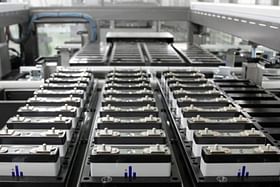Sodium-ion batteries (SIBs) have emerged as a potential alternative to traditional lithium-ion batteries (LIBs) for automotive applications.
So, what are SIBs and how do they differ from incumbent lithium-ion batteries?
Lithium-ion Batteries
In the world of electrochemical batteries, lithium-ion is the king — due to its light weight and longer life cycle. However, the main reason for their high adoption in electric vehicle (EVs) is their high energy density.
High energy density allows lithium-ion batteries to store more energy in less weight/volume, which is an ideal requirement for e-mobility applications.
Also, lithium-ion batteries heat up quickly, which means extra money is needed to build up safety.
Unfortunately, traditional LIBs are approaching its physico-chemical limit. The demand for higher density (longer range), high power (fast charging), and safer EVs has recently created a resurgence of interest in other cell chemistries.
Benefits Of Sodium
Just like LIBs, SIBs contain an anode, cathode, separator, and some form of liquid electrolyte. However, rather than a lithium (Li) charge carrier, sodium (Na) is used.
The key areas where Sodium scores better than Lithium include:
- Safety: SIBs provide enhanced safety in comparison to LIBs. Sodium exhibits lower chemical reactivity than lithium, thereby decreasing the chances of thermal runaway (which is, overheating) or fire hazards commonly associated with lithium-based batteries.
- Environmental Footprint: The extraction of lithium can cause significant harm to the environment due to extensive mining and chemical processing. On the contrary, sodium extraction is more sustainable, thereby mitigating the environmental, social, and governance (ESG) implications associated with the production of batteries for mass-market battery electric vehicles (BEVs).
Energy Density
The primary challenge faced by SIBs is their lower energy density compared to LIBs.
That means in order to store the same amount of energy, a sodium-based battery will need to be bigger and heavier than the equivalent lithium-based one. For EVs, that means a shorter range for a battery the same size.
This limitation directly impacts the driving range and overall performance of electric vehicles, making SIBs less ideal for specific applications that demand high power or long endurance.
Supply-Price Volatility
However, one area where Sodium has a distinct advantage is its abundant supply — the earth’s crust contains about 1,300 times more of sodium than lithium, itself hardly a rare commodity.
The geological abundance of sodium makes it cheaper to extract, thereby, enabling potentially lower production costs, making SIBs an attractive option for EVs.
Compare this with lithium’s supply problems which has pushed up the prices of the ‘white gold’ — the metal still accounts for about 40 per cent of the cost of a lithium-ion battery cell.
Lithium carbonate prices rose 13-fold between early 2021 and late 2022. Analysts believe that the further increase in prices of lithium would only add to increase in prices of batteries.
On the other hand, sodium currently trades at about one-tenth the price of lithium. In theory, that makes for a much cheaper battery.
To put into perspective, the real reason for sodium-ion’s sudden surge in popularity is that lithium mines and processing facilities are straining to meet skyrocketing demand for EV batteries.
Commercial Roll-out
Sodium-ion batteries have been knocking around for some time, but it is only now that the major players have started commercialising the technology.
Chinese battery giant Contemporary Amperex Technology Ltd (CATL) currently leads the industry in sodium battery production.
A number of automakers including listed EV makers JAC and BYD, and privately held Chery are planning to launch cars powered by sodium batteries this year.
What Next
Energy experts say somewhat easier market for sodium-ion batteries can be used for stationary storage installations, like those used to provide backup power for a home or business or on the electrical grid.
However, if market conditions have created opportunities for lithium alternatives, they can also swiftly eliminate them.
The future prospects of sodium-ion batteries are “directly tied to the cost of lithium”, according to Jay Whitacre, a battery researcher at Carnegie Mellon University and former founder of Aquion, a sodium-ion battery company.
In the scenario where sodium-ion batteries are gaining traction in the market due to cost and material accessibility, a decline in lithium prices could pose significant challenges for them.
“It’s hard enough to make new batteries and build them at large scale, it’s even harder to chase a moving target of ever-improving lithium-ion batteries that are getting cheaper”, says Whitacre.


